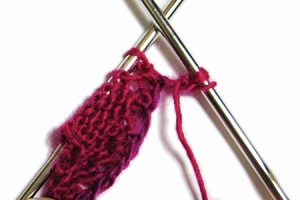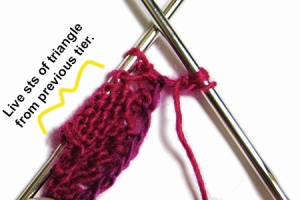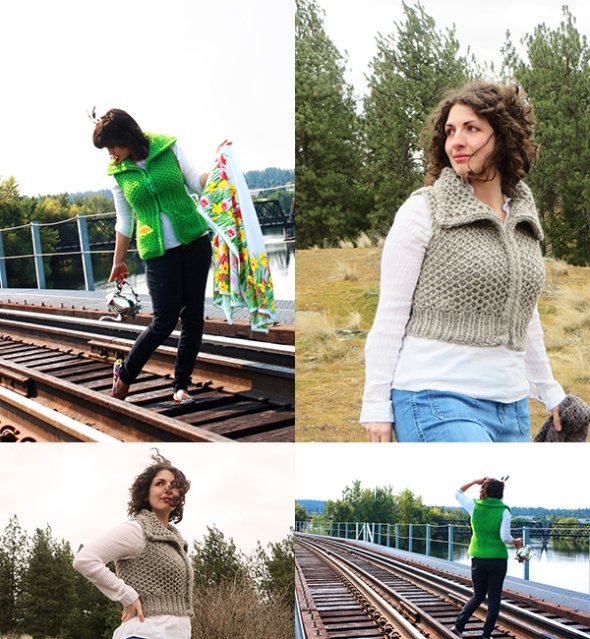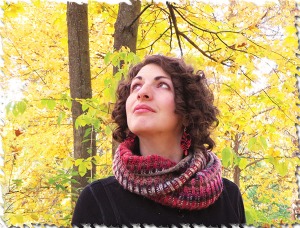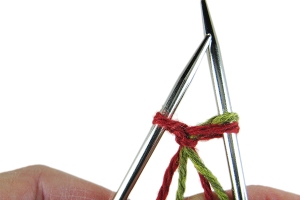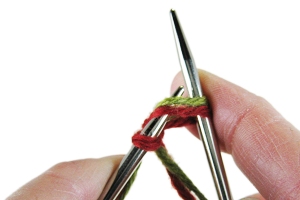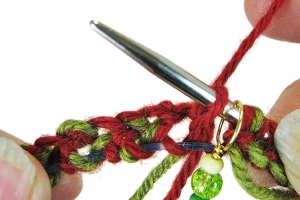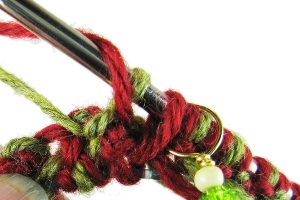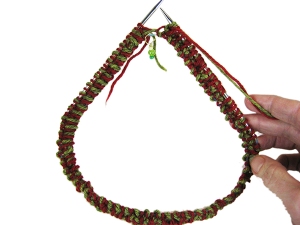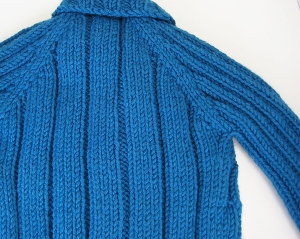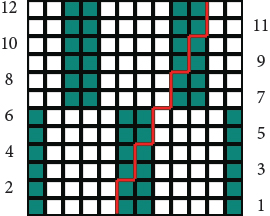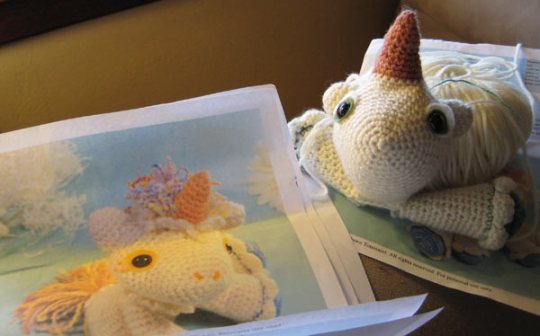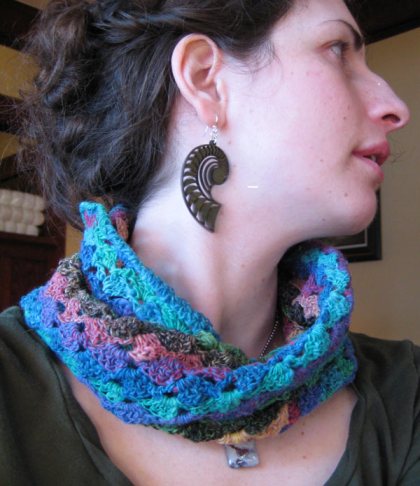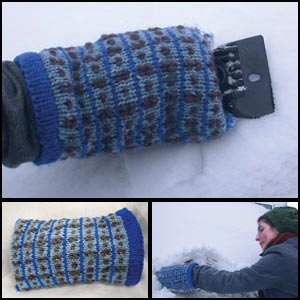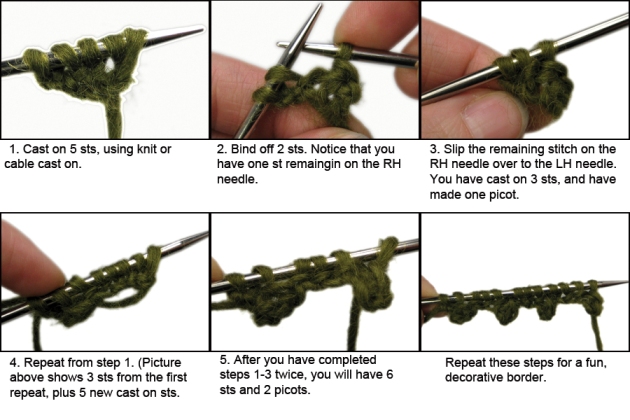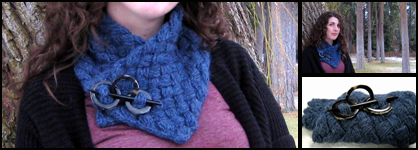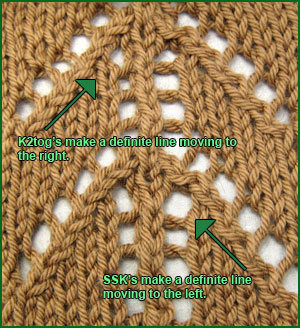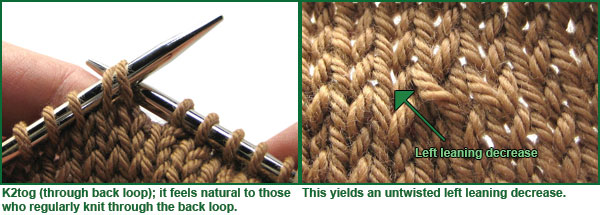I love striping yarns; they’re exciting, surprising, adventurous. I do, however, frequently find myself struggling to match them to a project because, when it comes down to it…I don’t really like….stripes. all that much. *sighs*
Don’t get me wrong, stripes are great, but I really, really need to be in control of them when I knit them. If I put stripes on something, I generally want to know beforehand exactly where they are going to go, what color they are going to be and how long they are going to last. (Socks are the exception to this, however, there are rare times when I am not in the mood to knit socks, or when all my sock needles have other sock projects on them.)
Note that the two preceding paragraphs present concepts that are largely antithetical. This is not lost on me. I enjoy the sense of spontaneity required in letting go and just allowing the stripes to happen as they will, but when it comes down to it, I am often disappointed with the finished item. The upshot is that I often end up beginning and then ripping out projects with striping yarns several times before just giving up and knitting…Entrelac.
If you are not familiar with it, entrelac is a knitting technique that involves creating a network of squares, rectangles, and/or triangles that are attached to each other. The end fabric looks something like this:
 This bit of green loveliness is knit in Zauberball Crazy, of which, we currently have several new colors. Because the fabric is worked in a series of small squares, the striping is broken up, and, as if by magic, wherever the colors land, it generally looks pretty amazing.
This bit of green loveliness is knit in Zauberball Crazy, of which, we currently have several new colors. Because the fabric is worked in a series of small squares, the striping is broken up, and, as if by magic, wherever the colors land, it generally looks pretty amazing.
Recently, I knit a fantastic entrelac shawl pattern for my LYS (available from Eva Martinsson on Ravelry).
As often happens when a sample is knit for a shop, our customers decided that they really wanted to knit it (of course, that’s the point). What followed was a Summer of, “Um…where am I in this pattern?”, “Which way am I going?”. Now, don’t misunderstand, the pattern is perfectly fine. In fact, I have knit a second one since (the green pick above) and will probably knit another. Entrelac involves interacting with your knitting in a different sort of way than we are used to, and this pattern in particular puts a little bit of a spin on the technique. As a result, people who had not previously knit entrelac, but who wanted to knit that shawl, often found themselves a bit lost. What follows is an introduction to the basic concepts involved in entrelac knitting, as well as some examples of places where you might wonder something like “which way am I going?” and explanations of how to figure that out.
Before we begin, though, I would like to point out some of my favorite yarns for knitting entrelac. First, off, while you can certainly knit entrelac with any yarn, I prefer self-striping yarns. In fingering weight, we have Zauberball and Zauberball Crazy. These are my particular favorites. We also have Noro Silk Garden Sock and just a little bit of Kureyon Sock left. If you want something heavier, we have Noro Kureyon (only a few colors, but a sweater’s worth in some of them) and Cascade Casablanca. For heavier projects still, we have Rowan’s Colourscape Chunky. So many to choose from!
Now, on to entrelac!
 Here is your basic entrelac swatch. Note: because it is fairly narrow, there is still a fairly robust striping pattern. In a wider project, the stripes will be more broken up, and we will see all sorts of interesting color play happening, as in the shawl above.
Here is your basic entrelac swatch. Note: because it is fairly narrow, there is still a fairly robust striping pattern. In a wider project, the stripes will be more broken up, and we will see all sorts of interesting color play happening, as in the shawl above.
The following explanation will consist of:
1. The building blocks of entrelac and how they relate to each other in space.
2. The actual pattern instructions. These are very basic instructions and may differ from other patterns you have encountered in one or two ways (different increases or decreases). The basic idea, however, is the same.
3. The recipe for entrelac. Entrelac is based on a very specific series of steps. We can modify these steps to make our projects different sizes and shapes.
4. “Where am I?” – examples of situations that might give you pause and explanations of how to reason your way out of them.
Now, having worked in yarn stores for about 10 years, I know that people learn different ways which, as I often say, is OK. For some people, reading an overview of structure is not helpful. If this is you, feel free to skip right to #2 and follow the instructions. Then, if you want, you can come back and read the description of what you just did. If you like to know what you are doing before you start, full steam ahead!
1. Building Blocks of Entrelac
We generally think of knitting in terms of rows and stitches. With entrelac, we add two more levels of organization: Rectangles/triangles (which consist of rows and stitches) and tiers (which consist of rectangles/triangles).
The different elements:
Base Triangles: These are the triangles that line to bottom of your work (orange in the picture above). In the swatch above and in the instructions below, the stitches of the base triangles lean to the left. Take a look below to see what I mean.
Each base triangle begins and ends with a RS row (note that this means there is an odd number of rows). These triangles make up Tier 1.
Left Edge Triangle: You can see this little fellow on, well, the left edge of the picture above. Notice that he leans to the right. Also note that, when I say “left edge”, I mean when you are looking at the RS of your work. (Oh boy…) At the risk of sounding like an Abbot and Costello routine, I do want to point out, that when you are starting your Left Edge Triangle, you will begin with a WS row and to it will actually appear that you are working on the right edge. When in doubt, look at the RS of your work. This is the side with the knit stitches facing.
Right Leaning Rectangles: These rectangles, along with the left and right edge triangles, comprise your Tier 2 and all even numbered tiers. The stitches for these are picked up along the right edge (looking at the RS) of your base triangles (or the rectangles from the previous tier later on). You pick up stitches for these from the wrong side, and knit your first row on the RS. You will always end these rectangles on a WS row. **You don’t have to memorize this rule because the knitting will tell you what you have to do.**
Right Edge Triangle: This is the last blue arrow on the swatch above and the last element of Tier 2. It begins and ends with a RS row.
Left Leaning Rectangles: The stitches for these rectangles are picked up along the left edge of your Tire 2 (or even tier) elements, with the RS facing. The actual rectangle begins with a WS row and ends with a RS row.
Top Triangles: These line the upper edge of the piece, creating a smooth (rather than jagged) top. Sts are picked up on the RS. Each Triangle begins with a WS row and ends with a RS row (more or less)
How they relate to each other:
I mentioned that the stitches for some elements are picked up from the edge of other elements. Here is what that looks like (sort of).
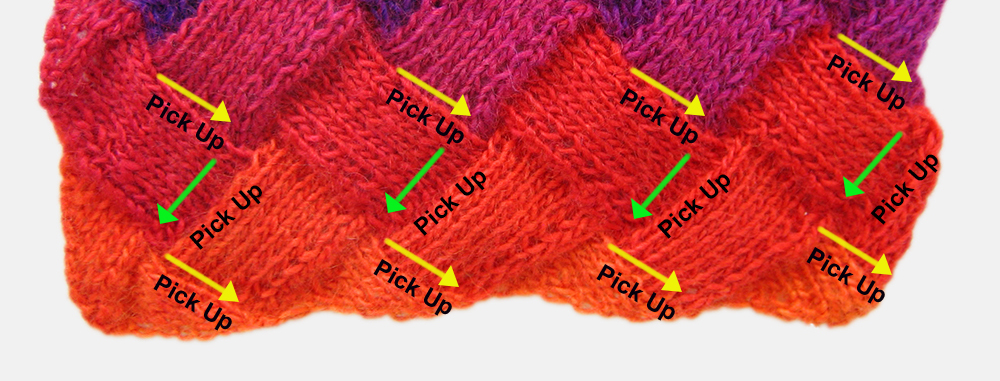 As shown above, the picking up happens from left to right for even numbered tiers. Remember, though that that is from the RS perspective. I mentioned above that we pick up stitches for Right Leaning Rectangles from the WS. Thus, we are actually working from right to left, but looking at the wrong side. Yikes.
As shown above, the picking up happens from left to right for even numbered tiers. Remember, though that that is from the RS perspective. I mentioned above that we pick up stitches for Right Leaning Rectangles from the WS. Thus, we are actually working from right to left, but looking at the wrong side. Yikes.
Here’s another picture. This shows the direction of knitting within each rectangle and tier.
I think that’s enough abstract spatial reasoning for now. Let’s just do some knitting.
2. Basic Entrelac Instructions
Tier 1: Base Triangle
CO a multiple of 8 stitches.
R1: K1, turn.
*It may feel strange to turn while you still have sts on the LH needle, but don’t worry, you’ll get used to it.
R2: P1, turn.
R3: K2, turn.
R4: P2, turn.
R5: K3, turn.
R6: P3, turn.
R7: K4, turn.
R8: P4, turn.
R9: K5, turn.
R10: P5, turn.
R11: K6, turn.
R12: P6, turn.
R13: K7, turn.
R14: P7, turn.
R15: K8, do not turn.
You have now completed one triangle. It looks kind of funny.
There are currently 8 sts on your RH needle. You will now ignore these sts.
Repeat Rows 1-15 once. Note that you are working on the next group of 8 sts. When you are done with the second set, you will have two groups of 8 sts on your RH needle, separated by a gap.
Continue repeating Rows 1-15 until you end up with no sts on your LH needle after Row 15. Tier 1 is complete. This is the point where first time entrelac knitters usually say, “That can’t be right!” and tear it out. Don’t do that!
It should look like this:
Moving on…
Tier 2: Left Edge Triangle, Right Leaning Rectangles, Right edge Triangle
Left Edge Triangle:
R1 (WS): P2, turn.
R2: K2, turn.
R3: Pfb, p2tog, turn. (Note that your ‘p2tog’ consisted of one st from your row and one st from the previous base triangle. On every WS row, you will be “using up” one of the sts from the group of 8 sts immediately to the left of your current sts. There will always be 8 sts in the immediate vicinity of where you are working; some will be from your current group, some will be from the previous tier.)
R4: K3, turn.
R5: Pfb, p1, p2tog, turn.
R6: K4, turn.
R7: Pfb, p2, p2tog, turn.
R8: K5, turn.

The sts of the new section, plus the sts of the closest section from the previous tier should always add up to 8.
R9: Pfb, p3, p2tog, turn.
R10: K6, turn.
R11: Pfb, p4, p2tog, turn.
R12: K7, turn.
R13: Pfb, p5, P2tog, do not turn.
The edge triangle is now complete. There are 8 sts (the sts of the edge triangle) on your right hand needle; ignore them. Place a marker on your RH needle, to mark the boundary between the sts you have just finished with and the next section. You will probably not need this marker after a couple more rows.
Right Leaning Rectangle
With WS facing, pick up and knit 8 sts along the adjacent edge of the triangle from the previous tier.
If you find it easier, you can do this with the RS facing, picking up from left to right (if you find this easier, I’m guessing you are probably left handed).

2 sts have just been picked up. Notice that the marker indicates the boundary between the sts of the previous section and the sts that you have just picked up.
Once the stitches are picked up, turn your work so that the RS is facing.
R1: K8, turn. (You have just knit to the marker. Soon, there will be a big gap between the sts of this rectangle and the sts of the edge triangle – which we are ignoring- rendering the marker unnecessary.)
R2: P7, p2tog, turn. (Note: your p2tog consists of one of the picked up sts and a sts from one of the groups of 8 from a previous tier.)
Repeat these two rows a total of 8 times; do not turn after the last rep of R2. At this point, there will be not more sts readily available for your p2tog. This is one way that your knitting can help you figure out what to do. If there are no more sts for your p2tog, it’s time to pick up again.
Repeat the process (from the beginning of the Right Leaning Rectangle section) until all the sts from the previous tier have been used up and there are no sts left on your LH needle after your last p2tog.
Right Edge Triangle
This is the last piece of Tier 2. Pick up 8 sts as before, this time along the last remaining available edge, and turn work so that you are looking at the RS.
R1(RS): K8, turn.
R2 (and all WS rows): Purl to 2 sts before end, p2tog.
R3 (and all RS rows): Knit to end of triangle sts (there will be a big gap before the sts of the previous rectangle), turn.
Repeat Rows 2 and 3 until only one sts remains. This stitch will stay on the RH needle and be the first of your next group of 8 sts.
Tier 2 Complete! Yay!
Tier 3: Left Leaning Rectangles
After all the hullabaloo of Tier 2, Tier 3 is relatively easy.
With RS facing and 1 st already on your RH needle, pick up and knit 7 sts from the adjacent edge.
R1 (WS): P8, turn.
R2: K7, ssk, turn. (Note: the ssk consists of one picked up st and one of the 8 sts from the previous tier’s rectangles).
Repeat Rows 1 and 2 until all sts of previous rectangle have been used up.
Repeat this process (picking up 8 sts along subsequent edges) until all groups of 8 sts have been used up and there are no more sts on the LH needle.
Tier 3 accomplished!
Now, repeat Tiers 2 and 3 until your piece is long enough, ending on Tier 2.
Top Triangles
One st remains on RH needle from last triangle; this counts as first picked up st. Pick up and knit 7 more sts (8 sts total).
R1 (WS): P8, turn.
R2: Ssk, k5, ssk, turn.
R3: P7, turn.
R4: Ssk, k4, ssk, turn.
R5: P6, turn.
R6: Ssk, k3, ssk, turn.
R7: P5, turn.
R8: Ssk, k2, ssk, turn.
R9: P4, turn.
R10: Ssk, k1, ssk, turn.
R11: P3, turn.
R12: Ssk, ssk, turn.
R13: P2, turn.
R14: Sssk, turn.
R15: P1, turn.
R16: Ssk, do not turn.
Repeat from beginning of top triangle section until all sts on LH needles are used up and only one st remains on RH needle. BO remaining st.
3. Recipe for Entrelac
So there we go. You can use these instructions to make a scarf or shawl. Now, you might wonder, how wide can I make this shawl or scarf? What if I want my rectangles to be bigger?
The second question is the easiest to answer. Remember how you cast on a multiple of 8 for the practice swatch? And then, you always started each section with 8 picked up sts? And the number 8 just kept showing up everywhere, like in the very last row of your base triangle instructions? Well, that “8” can be any number you want, all you have to do is continue working in the pattern established in the instructions.
As for the second question, you will adjust your cast on to get your scarf/shawl/wrap to whatever width you want. You may have to do some swatching to figure out how many more sts to cast on, though.
4. Where am I?
Earlier in the post, I made certain wild claims that entrelac fabric can actually give you very useful clues about where you are in the pattern. I have put together some examples of questions people have brought to me in the past and how we talked our way through them.
First:
 You can’t really see it in this picture, but the yarn is coming off the right hand needle, so we know that we are on a WS row, or just getting ready to turn.
You can’t really see it in this picture, but the yarn is coming off the right hand needle, so we know that we are on a WS row, or just getting ready to turn.
How do we know which one it is? Let’s have a look at the RS.
Note: when in doubt, I like to look at the RS, just because I find it a little easier to get my bearings. In general, it is never a bad thing to just pause and take a look at the big picture of your knitting. It is really easy to get lost in the little details, but often, when you take a look at what is surrounding the details, things become a little clearer.
 Once I’ve turned things around, I look at my groups of sts. I have a group of 8 (which is to be expected), a group of 7, and a group of 9. Notice that they all add up to a multiple of 8 (my magic number for this swatch). Any time you have 3 distinct groups of sts in the immediate vicinity of each other, they will consist of the following:
Once I’ve turned things around, I look at my groups of sts. I have a group of 8 (which is to be expected), a group of 7, and a group of 9. Notice that they all add up to a multiple of 8 (my magic number for this swatch). Any time you have 3 distinct groups of sts in the immediate vicinity of each other, they will consist of the following:
The sts you are currently working on (your current section).
The sts of the section you just finished.
The sts of the adjacent section from the previous tier.
The trick is to figure out which one is which. Well, clearly, the middle section (7 sts, plus one on the other needle) are your current sts. We know this because there are very close to the picked up edge, as opposed to the other groups, which have whole sections attached to them. The sts to the right (the group of 9, although one of those belongs to the current section) are the same color as the current sts. This indicates that these are from the section that you just finished knitting. That means that the group furthest to the left in the picture above are from a previous tier.
So now we know what’s what. How do we know what to do? We know that we have to get that 8th st into the center section. The question is, do we purl on and turn, (remember that we are actually on a WS row), or do we p2tog. We need to figure out if we are working on a right leaning or left leaning rectangle. Look at the 8 sts from the previous tier rectangle; their rectangle is leaning to the right. Just next to it is another rectangle leaning to the right. That is the rectangle that we picked up our current sts from. This means that we are currently working on a left leaning rectangle. Now, look at the instructions for the left leaning rectangle (repeated hear for your convenience):
R1 (WS): P8, turn.
R2: K7, ssk, turn. (Note: the ssk consists of one picked up st and one of the 8 sts from the previous tier’s rectangles).
Well, on the WS rows, we just purl, with not decreases at all, so when we see this:
we know we need to purl one more (to complete the 8) and then turn.
What about this?
This happens all the time, so if you find yourself in this situation, know that at least you are in good company.
You are working on a left leaning rectangle. See that line of Ssk’s that are eating up the sts of the previous tier? Notice that you have just knit past them. You just got a little carried away and forgot to ssk and turn. To fix this, undo the last 6 knits, ssk and then turn.
And what about this?
This is a little bit more involved. Again, we are on a left leaning rectangle, specifically, at the end of a RS row. Normally, we should be doing a decrease here, but what is this?
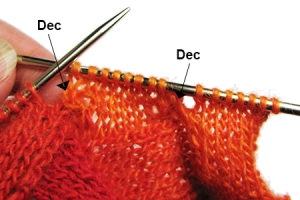 We appear to have decreases on both sides! Also, the section on the right has only 7 sts.
We appear to have decreases on both sides! Also, the section on the right has only 7 sts.
On the last WS row, I accidentally did a p2tog, then turned. I need to undo this whole row (8 sts, including the decrease), turn and then work the RS row of my rectangle.
There we go! everything is fixable. The important thing, though is to catch mistakes like these as soon as possible. We do this by taking time to stop and look at the project as we go along. Note: this is it’s own reward, since our projects are very pretty.
Do you have an entrelac project that is stuck? Send me a pic and we’ll see if we can get it figured out!
Have fun!






